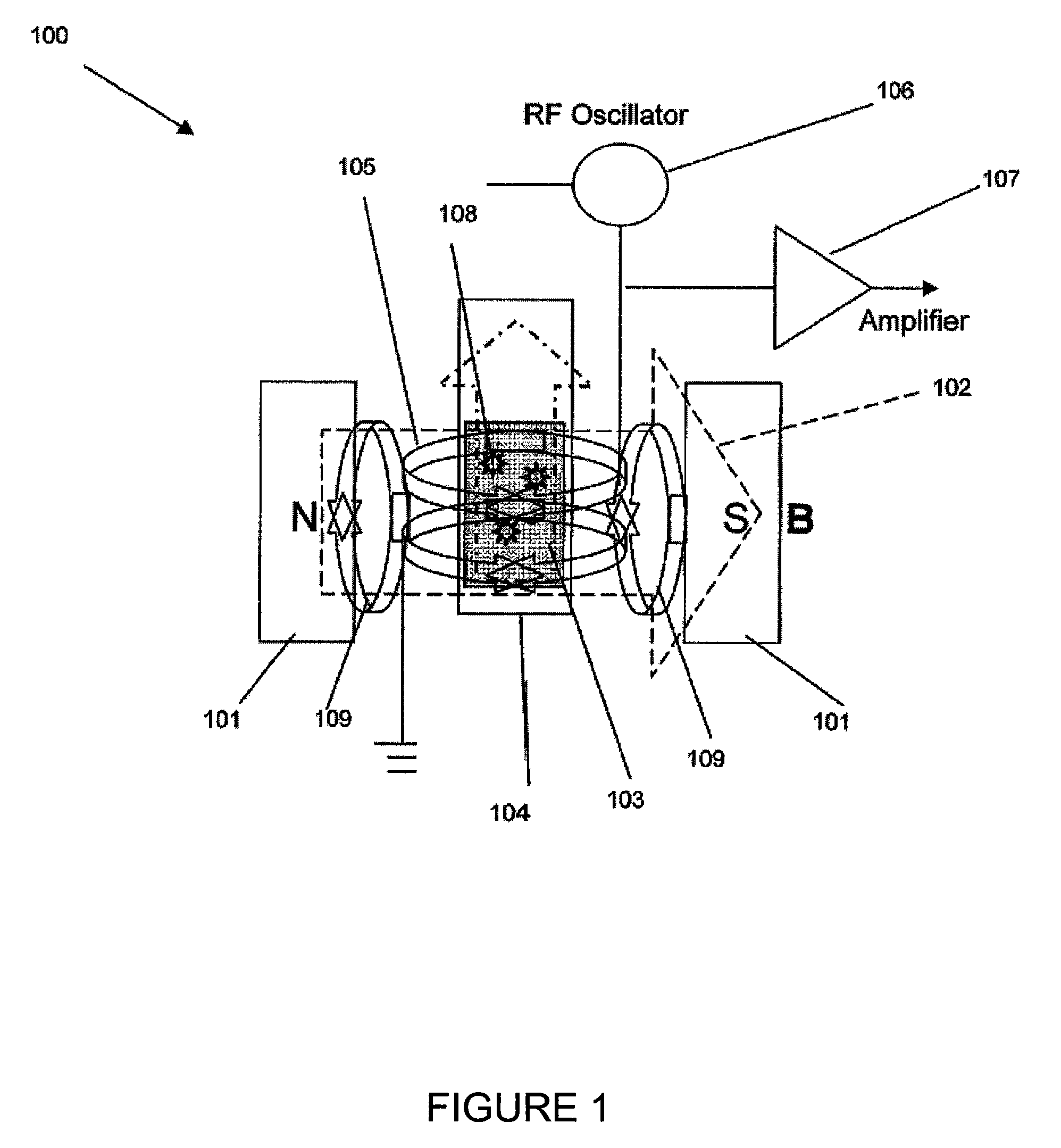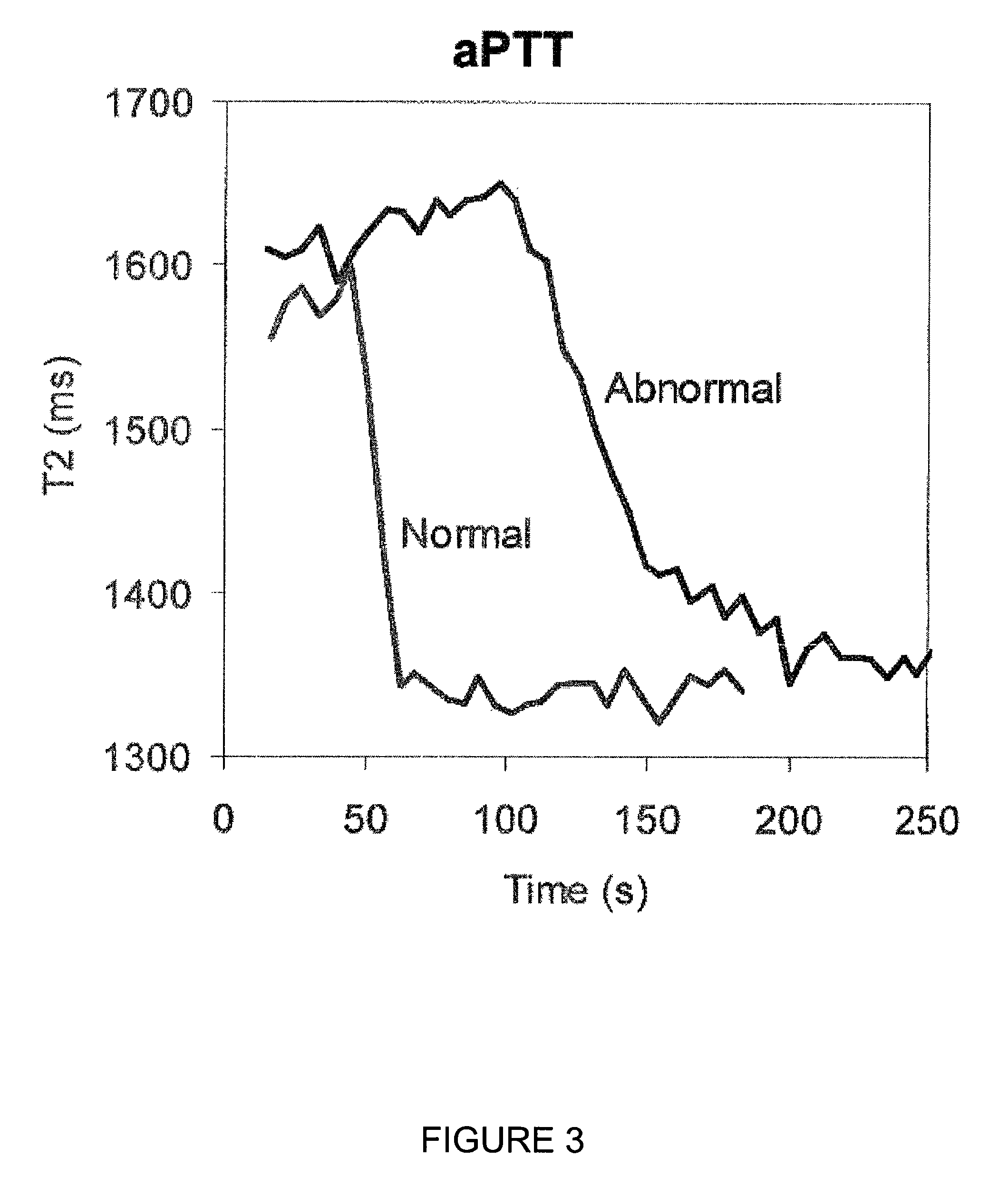NMR detection of coagulation time
a technology of coagulation time and nmr, which is applied in the direction of nmr measurement, biochemistry apparatus and processes, instruments, etc., can solve the problems of uncontrollable bleeding or formation of unwanted blood clots, unsuitable or inconvenient for point of care testing or home use, and achieve high time-resolved accuracy and accuracy at the point of care setting
- Summary
- Abstract
- Description
- Claims
- Application Information
AI Technical Summary
Benefits of technology
Problems solved by technology
Method used
Image
Examples
example 1
Coagulation Time Measurement in Plasma Using T2 Relaxation
[0081]A Bruker Minispec mQseries (The Woodlands, Tex.) was adapted with pulse sequences for T2 monitoring in real time. Several effective T2 measurements made within 30 to 40 seconds and transverse relaxation times of plasma samples were measured every 5 seconds. Coagulation of a sample was induced by addition of calcium chloride to a mixture of reconstituted plasma (CITREX® I lyophilized plasma preparation, BIODATA Corporation, Horsham, PAS) and an aPTT reagent (CEPHALINEX® activated partial thromboplastin time reagent BIODATA Corporation, Horsham, Pa., USA).
[0082]T2 measurements were made kinetically on a Bruker MQ minispec using preloaded minispec software with the following CPMG settings:[0083]1. Tau=0.25[0084]2. Number of Points=1000[0085]3. Dummy Echos: 3[0086]4. Recycle Delay: 1[0087]5. 0 dB pulse at 37° C.[0088]6. Receiver gain: 75[0089]7. 1 scan
[0090]Coagulation time was estimated by curve analysis completed by midpo...
example 2
Coagulation Measurements Using Pooled Normal and Single Donor Abnormal Samples via T2 Relaxation
[0091]Real patient plasmas were purchased through George King Bio-Medical and used within 2 hours following thawing. Both normal and abnormal samples were run in duplicate to provide experimental error (averages are shown). Duplicate sampling resulted in a more precise coagulation time compared to the reference (start-4) data. (Note: standard deviation of samples controlled two factors: effective T2 values, coagulation time).
[0092]Measurement of changes in T2 relaxation time over time were taken. Measurements were made kinetically on a Bruker MQ minispec using preloaded minispec software with the following CPMG settings:[0093]1. Tau=0.25[0094]2. Number of Points=1750[0095]3. Dummy Echos: 3[0096]4. Recycle Delay: 1[0097]5. 18 dB pulse at 37° C.[0098]6. Receiver gain: 75[0099]7. 1 scan
[0100]Curve analysis was completed to generate coagulation times by midpoint determination between the T2 i...
example 3
Correlation Between Coagulation Method Results Obtained Using a Method of the Present Invention and Results Obtained with a Commercial Bench-top Coagulation Instrument
[0103]For aPTT measurements, 100 μL of patient plasma and 100 μL of PTT-A (Diagnostica Stago) were pre-warmed to 37° C. in a 5 mm NMR tube. 100 μL of calcium chloride pre-warmed to 37° C. was added to the plasma and clotting reagent activating coagulation. For PT measurements 100 μL of patient plasma and 200 μL of Neoplastine CI Plus (Stago Diagnostica, Parsippany, N.J.) pre-warmed to 37° C. were mixed activating coagulation. Measurements were made kinetically on a Bruker M Q minispec using preloaded minispec software with CPMG parameters described in Example 2. Curve analysis to generate coagulation times was completed by midpoint determination between the T2 intial and T2 final.
[0104]Prothrombin Time (PT) and Activated Partial Thromboplastin Time (aPPT) of plasma samples were measured using a Bruker Minispec mQseries...
PUM
| Property | Measurement | Unit |
|---|---|---|
| dwell time | aaaaa | aaaaa |
| prothrombin time | aaaaa | aaaaa |
| prothrombin time | aaaaa | aaaaa |
Abstract
Description
Claims
Application Information
 Login to View More
Login to View More - R&D
- Intellectual Property
- Life Sciences
- Materials
- Tech Scout
- Unparalleled Data Quality
- Higher Quality Content
- 60% Fewer Hallucinations
Browse by: Latest US Patents, China's latest patents, Technical Efficacy Thesaurus, Application Domain, Technology Topic, Popular Technical Reports.
© 2025 PatSnap. All rights reserved.Legal|Privacy policy|Modern Slavery Act Transparency Statement|Sitemap|About US| Contact US: help@patsnap.com



